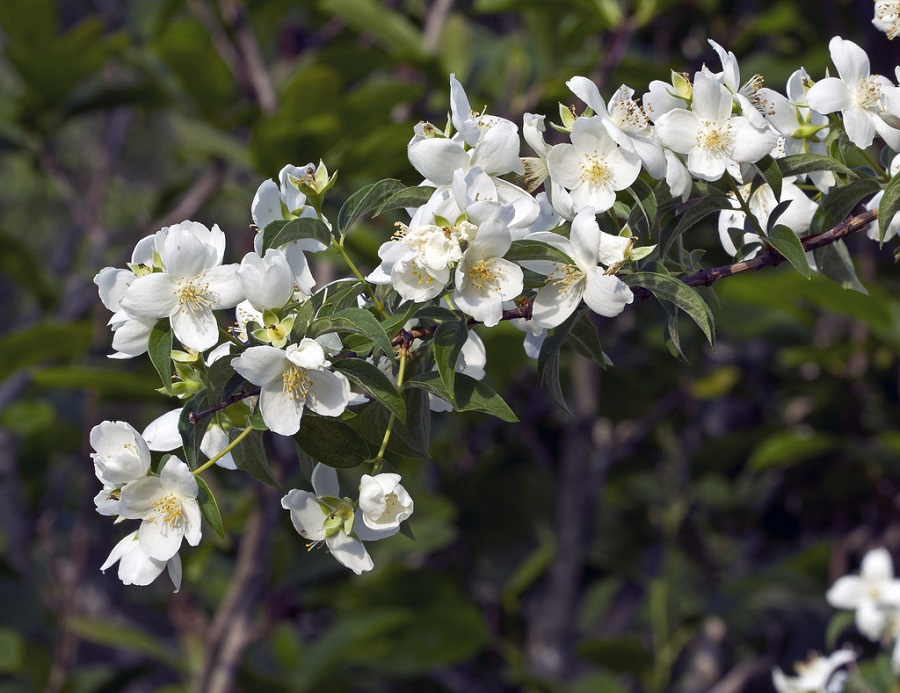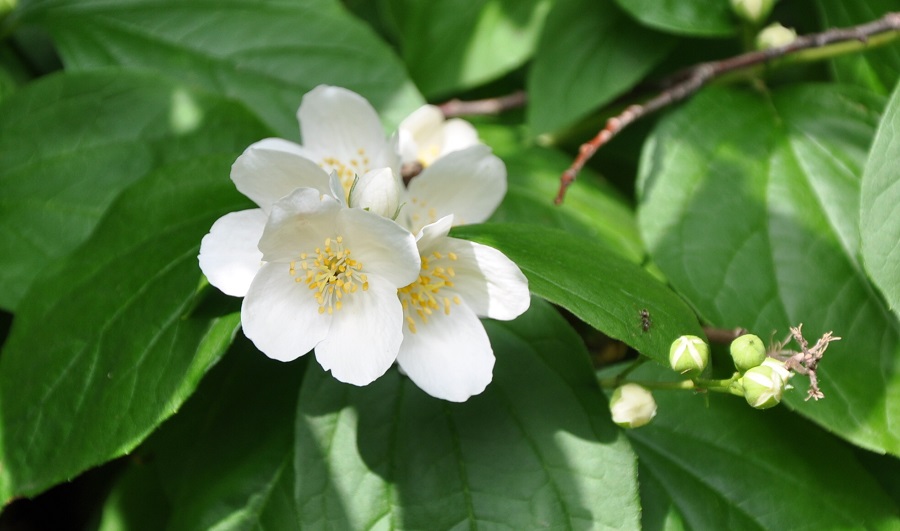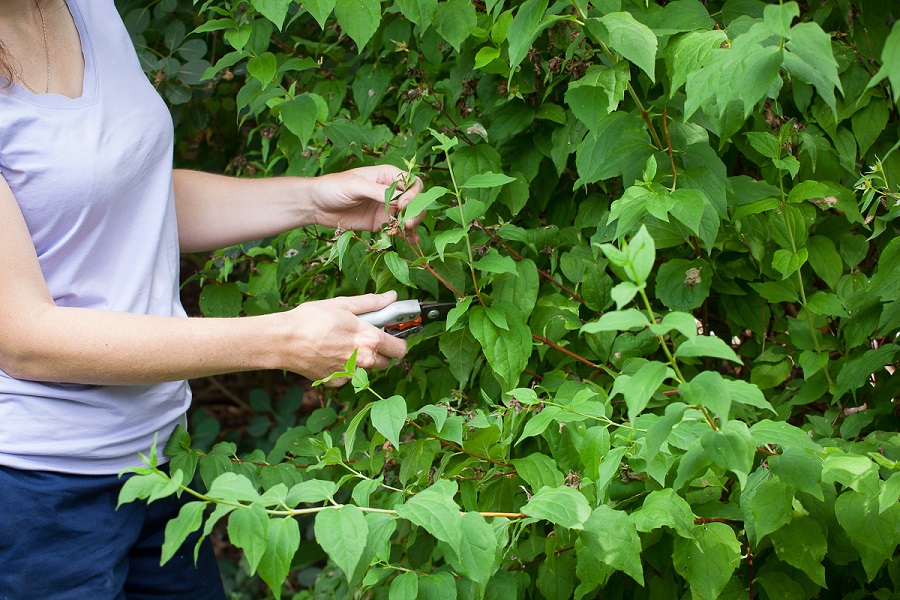Mock Orange Bush - Varieties, Pruning, Propagation and Care
Mock orange _(Philadelphus)_ is an easy to grow garden bush. It's not a demanding plant – for this reason it's perfect for all gardeners, regardless of their experience. Because of its fast growth rate and width, along with many amazingly fragrant flowers, it's a common decorative element in gardens. Check what does a mock orange need and learn about its varieties. Refresh your garden.

Mock orange – what kind of plant is it and what does it look like?
Sweet mock orange, or Philadelphus coronarius, is a plant from the hydrangeaceae bushes. Many people confuse it with jasmine – but it’s not the same species. There are over 70 varieties of this plant. It grows naturally in Turkey, the Caucasus, on Aegean Islands, but also appears in Italy and southern regions of Australia.
Depending on the variety, mock orange can grow up to 3 meters tall. It’s characteristic for its fast growth rate and wide habit. Its young branches are straight, and gradually become bent with age. Mock orange leaves reach up to 8 centimeters in length.
The four-petal white-and-cream flowers are an unquestionable attraction of this plant. The large flowers growing on this shrub develop a magnificent fragrance during the blooming season. So, this ornamental bush is not only a beautiful decoration of the yard, but also an olfactory delight for anyone who passes by.

The most popular mock orange varieties
Mock oranges are available in over a dozen different varieties. But in fact, there are three most popular and most interesting varieties known everywhere in the world. They are:
- Aureus – golden leaves and intense-smelling white flowers are its main features,
- Dwarf mock orange – this variety develops an abundance of flowers compared to other types, and has characteristic wavy leaves,
- Variegata – double-colored green-and-white leaves are the characteristic feature of this variety.
Do mock orange bushes need a special soil for growth?
Sweet mock orange is very easy to grow and doesn’t have any serious requirements. When picking a location for this bush, pick a spot in full sun. This way, the plant can bloom better. A Philadelphus planted in a shaded place grows well, too, but don’t expect rich blooming from such a plant.
The bush grows best in clay soil with moderate moisture levels. The pH can be lightly alkaline or lightly acidic. If you lack gardening experience, you can use a soil mix purchased in a gardening store to achieve the proper pH level.

Mock orange – what is its growth rate?
Sweet mock orange is a fast-growing bush. It achieves its maximal size in a relatively short time. To control the plant’s size, one should remember about regular pruning.
Many people appreciate the fast growth rate and the wide shape of the plant, as these features might be quite beneficial. Because of them, the plant is often used as a hedging shrub or a lane plant. Thanks to this, one can find shelter in its shade.
When to plant mock oranges?
Fall is the best season for planting mock oranges. Before planting the bush in a particular place, soak the root ball in water. Make sure to stir up the soil in which the Philadelphus is going to grow, and remove any remaining weeds.
The hole for the bush should be at least twice as large as its root ball. Thanks to this, the roots have enough room to spread, and you can be sure the bush will take root.
Climbing mock orange, one of the shrub’s varieties, needs similar preparation before planting.

Mock orange – watering and fertilizing
A freshly planted mock orange bush requires a lot of water. Avoid letting the soil dry completely or allowing water to stand in the soil. Both situations are equally dangerous.
Mock orange is quite a demanding bush regarding its nutritional needs. Fertilizing the shrub with organic material is particularly important, especially after planting young mock oranges. Older plants require feeding once per year, every spring.
Avoid fertilizers with a high nitrogen content. A high concentration of this ingredient makes the plant grow well, but without any flowers.
How to propagate a mock orange bush?
Philadelphus is an easy plant to propagate. You can pick between two methods – whichever is easier for you.
- Retrieving green cuttings directly from the bush in summer is one of the most popular methods.
- Another method involves using woody cuttings retrieved in winter.
To make the entire process quicker, you can use rooting hormone. Place the cuttings in pots filled with soil for the best growing conditions.

Mock orange pruning – is it essential?
Note that some bushes require regular pruning if you want to control them – it’s true for mock oranges as well. Trimming of the shrub is recommended if you want to correct its growth and shape it in a particular way.
- The first pruning should be performed within the plant’s first 3-4 years.
- Any corrective cuts should be done after the plant finishes blooming.
- Rejuvenating pruning is reserved for fall and winter, once the plant loses its leaves.
Mock orange – most common diseases
Mock oranges are vulnerable to various diseases. Leaf blotch is one of them. The disease usually appears on the bush at the end of summer. That’s when one can notice brown spots on the leaves. The leaves become dry wherever the spots appeared, and they begin to crumble, leaving holes. Special fertilizers against blotchiness are the best solution – you can purchase them in gardening stores.
The bush is also vulnerable to botrytis. The disease spreads particularly well during a rainy summer. The disease attacks flower petals, which become black and covered with powdery residue.
Are mock oranges vulnerable to pests?
As for pests, black bean aphids are the biggest threat to mock oranges. This type of aphids appearing on the shrub deform Philadelphus’s leaves and cover them with a sticky residue. Special sprays are needed to get rid of the pest. We recommend trying natural ones, and if they don’t work – use chemical products.

📍 What does a mock orange look like?
Mock orange is a decorative bush. Its wide habit is the characteristic feature. Depending on the variety, it can grow from 1 to even 3 meters tall. It has a sweet and very intense scent spread by the white-and-cream flowers.
📍 Does mock orange grow fast?
Mock orange grows extremely fast. To control its growth, one has to prune it regularly. Thanks to this, one can form it into a particular shape.
📍 How to propagate a mock orange?
Propagating mock oranges is not a challenge for a gardener. Use half-green cuttings gathered in summer, e.g., in July. You can also use woody cuttings harvested in winter.
📍 When do mock oranges bloom?
Mock oranges bloom in various months, depending on the variety. But typically, it happens at the beginning of May and early June.
Featured articles




